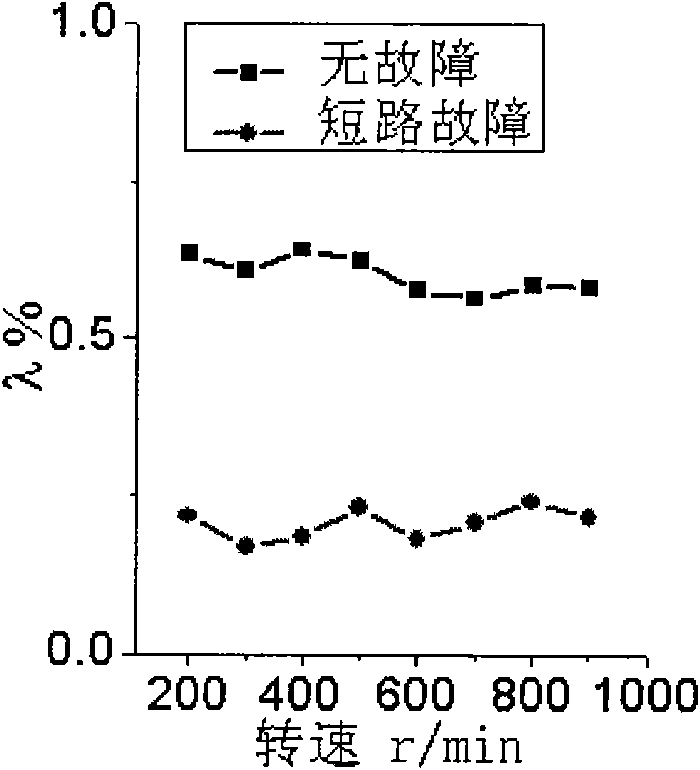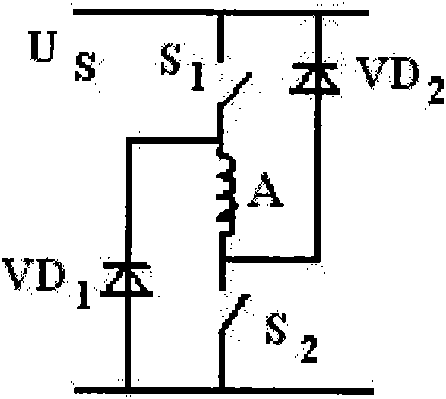Fault diagnosis method for power converter of switch reluctance motor
A power converter and fault diagnosis technology, which is applied to the measurement of electrical variables, motor generator testing, instruments, etc., can solve the problems that the system cannot judge the type and location of the fault, and does not have the functions of fault detection and fault location.
- Summary
- Abstract
- Description
- Claims
- Application Information
AI Technical Summary
Problems solved by technology
Method used
Image
Examples
Embodiment 1
[0023] Embodiment one, figure 2 As shown, taking the asymmetrical half-bridge (double switch) switched reluctance motor power converter as an example, S 1 and S 2 main switch, VD 1 and VD 2 It is a freewheeling diode, and the DC supply voltage is U S . Test the current spectrum of each phase when the power converter of switched reluctance motor is running without fault, and take the relative spectral ratio coefficient of each phase current as the fault characteristic quantity. If the relative spectral ratio coefficient of all phase currents is basically constant and does not change significantly, the power The converter is not faulty. If the amplitudes of the DC component and the fundamental component of the A-phase current are close to zero, an open-circuit fault occurs in the A-phase; compared with the relative spectral ratio coefficient of the A-phase current when no fault occurs, if the relative spectrum The ratio coefficient changes obviously, and the relative spec...
Embodiment 2
[0027] Embodiment two, image 3 As shown, taking the double-winding switched reluctance motor power converter as an example, S is the main switch, VD is the freewheeling diode, and the DC supply voltage is U S . Test the current spectrum of each phase when the power converter of switched reluctance motor is running without fault, and take the relative spectral ratio coefficient of each phase current as the fault characteristic quantity. If the relative spectral ratio coefficient of all phase currents is basically constant and does not change significantly, the power The converter is not faulty. If the amplitudes of the DC component and the fundamental component of the A-phase current are close to zero, an open-circuit fault occurs in the A-phase; compared with the relative spectral ratio coefficient of the A-phase current when no fault occurs, if the relative spectrum The ratio coefficient changes obviously, and the relative spectrum ratio coefficient of the A-phase current ...
Embodiment 3
[0031] Embodiment three, Figure 4 As shown, taking the capacitive voltage divider switched reluctance motor power converter as an example, S 1 and S 2 main switch, VD 1 and VD 2 It is a freewheeling diode, and the DC supply voltage is U S , C 1 and C 2 is the voltage divider capacitor. Test the current spectrum of each phase when the power converter of switched reluctance motor is running without fault, and take the relative spectral ratio coefficient of each phase current as the fault characteristic quantity. If the relative spectral ratio coefficient of all phase currents is basically constant and does not change significantly, the power The converter is not faulty. If the amplitudes of the DC component and the fundamental component of the A-phase current are close to zero, an open-circuit fault occurs in the A-phase; compared with the relative spectral ratio coefficient of the A-phase current when no fault occurs, if the relative spectrum The ratio coefficient chan...
PUM
 Login to View More
Login to View More Abstract
Description
Claims
Application Information
 Login to View More
Login to View More - R&D
- Intellectual Property
- Life Sciences
- Materials
- Tech Scout
- Unparalleled Data Quality
- Higher Quality Content
- 60% Fewer Hallucinations
Browse by: Latest US Patents, China's latest patents, Technical Efficacy Thesaurus, Application Domain, Technology Topic, Popular Technical Reports.
© 2025 PatSnap. All rights reserved.Legal|Privacy policy|Modern Slavery Act Transparency Statement|Sitemap|About US| Contact US: help@patsnap.com



